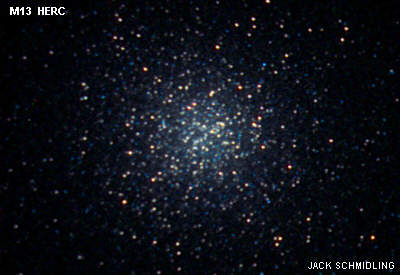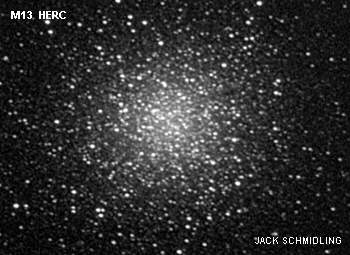
| ASTRONOMY PAGE | HOME PAGE |
![[m104]](herc.jpg)

M13 is probably the most looked at and most beautiful object that can be seen
in the Northern skies. Even modest amateur telescopes show it as a blazing ball
of stars. Again we can be glad that instruments have improved since the days of
Messier. When he cataloged this object as M13 in 1764, he described it as
a "nebula containing no stars". This is about what one sees in a pair of binoculars
today.
This color photo not only shows that it contains so many stars that it just becomes a blob of light in the core with long exposure but further that the stars come in several different colors.
Because of burnout in photos, it is difficult to determine the exact number of stars, especially in the central core where they are most numerous, but 30,000 stars have actually been counted and estimates are that the cluster contains something like one million stars.
The total luminosity of M13 is over 300,000 times that of the Sun and the total mass is equal to perhaps half a million Suns. The brightest members of the cluster are red giants, each as bright as 2000 Suns. It is interesting to note that looking back from M13 (a distance of about 21,000 light years), the Sun could not be seen visually in even the largest telescope.
It is also interesting to contemplate what the night sky might look like if we lived on a planet revolving around a star in M13. Contrary to what seems obvious, one would not be dazzled by a sky swarming with stars. There might be a dozen or so stars much brighter than any we see and perhaps a hundred as bright as our brightest but it would still get dark out. However, as it would be lighter than our darkest skies, we just might not have a clue of the dim galaxies and nebulae that lie outside our cluster. The Milky Way would probably be about as exciting as it is from the middle of football stadium at night.
The large scale photo was taken with the 150mm Metrogon camera at F8. It was an unguided 30 min exposure on hypered Techpan.
The color photo of M13 was taken with the 16" Newt. It was a 45 min exposure on PPF 400 film. Enlargement of negative is 10X and the print was scanned at 2X. The film was developed for 5 min in C41 chemistry.

![[m104]](m13.jpg)
The fuzzy patch in the upper right corner of this photo is NGC 6207 and is
typically the end of the story. It is usually photographed incidental to the most photographed object in the sky.

It should be pointed out that it's appearing on the same photo as M13 is simply a
result of them being in the same line of sight. M13 is about 21,000 light years away
and is in our own Milky Way galaxy while NGC 6207 is a remote spiral galaxy about
120 million light years distant.

M92 is frequently neglected by observers because of it nearness to the great M13. However, taken on it's own merit, it is one of the most beautiful clusters in the sky. It shines with the light of 250,000 Suns from a distance of about 35,000 light years.
This was a 10 minute exposure on the MX5 CCD camera. The telescope was the 16" Newt.
This page is under construction and new photos of other objects in the constellation will be added in future weeks.
HOME PAGE